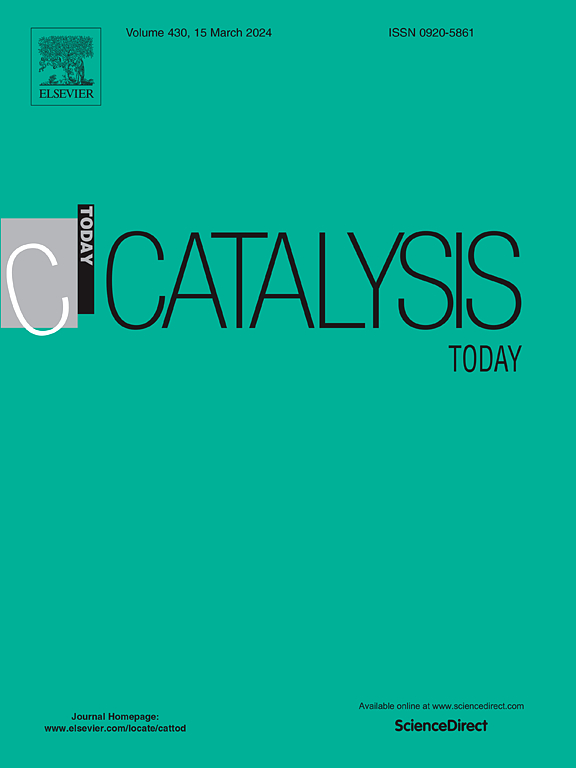Interfacial self-assembly of preformed colloidal nanocatalysts for pyrolysis upcycling of waste plastic
IF 5.2
2区 化学
Q1 CHEMISTRY, APPLIED
引用次数: 0
Abstract
Catalytic pyrolysis of waste plastics offers a sustainable approach to transform plastic waste into valuable carbon nanomaterials such as carbon nanotubes. Conventional methods for catalyst preparation provides limited control over catalyst morphology and loading. In addition, the powder catalysts remain entangled with the product carbonaceous materials and are difficult to separate. To mitigate these challenges, here, we present the first example of an interfacial self-assembly based approach for the construction of bulk catalysts with well-defined nanoscale morphologies for catalytic pyrolysis. The versatility of the self-assembly approach allowed us to deposit model Fe3O4 catalyst nanoparticles onto various types of supporting materials (S304, Ni, Ti, and Cu) to systematically investigate their impact on catalytic efficiency. Our studied revealed that CNT formation is influenced significantly by substrate-introduced effects. Among the tested supports, S304 system offered the highest selectivity for CNT growth, giving a carbon yield with a value of 207 mg/g plastic. While Ni and Ti generated more carbon products but with lower CNT mass ratio. Importantly, the self-assembled catalyst system also enables facile separation of carbon products from the support, offering a practical advantage over conventional powder-based systems. More broadly, our approach provides a versatile platform for designing robust and efficient catalysts with potential applications beyond plastic upcycling.
预成型胶体纳米催化剂在废塑料热解升级循环中的界面自组装
废塑料的催化热解为将塑料废物转化为有价值的碳纳米材料(如碳纳米管)提供了一种可持续的方法。传统的催化剂制备方法对催化剂形态和负载的控制有限。此外,粉末催化剂与产物碳质物质纠缠在一起,难以分离。为了缓解这些挑战,在这里,我们提出了基于界面自组装方法的第一个例子,该方法用于构建具有良好定义的纳米级结构的催化热解体催化剂。自组装方法的多功能性使我们能够将模型Fe3O4催化剂纳米颗粒沉积到各种类型的支撑材料(S304, Ni, Ti和Cu)上,以系统地研究它们对催化效率的影响。我们的研究表明,碳纳米管的形成受到底物引入效应的显著影响。在测试的支架中,S304体系对碳纳米管生长具有最高的选择性,其碳收率为207 mg/g塑料。而Ni和Ti则生成了更多的碳纳米管产物,但碳纳米管质量比较低。重要的是,自组装的催化剂系统还可以轻松地将碳产物从支架中分离出来,与传统的粉末基系统相比,具有实际优势。更广泛地说,我们的方法为设计稳健高效的催化剂提供了一个多功能平台,其潜在应用范围超出了塑料升级回收。
本文章由计算机程序翻译,如有差异,请以英文原文为准。
求助全文
约1分钟内获得全文
求助全文
来源期刊

Catalysis Today
化学-工程:化工
CiteScore
11.50
自引率
3.80%
发文量
573
审稿时长
2.9 months
期刊介绍:
Catalysis Today focuses on the rapid publication of original invited papers devoted to currently important topics in catalysis and related subjects. The journal only publishes special issues (Proposing a Catalysis Today Special Issue), each of which is supervised by Guest Editors who recruit individual papers and oversee the peer review process. Catalysis Today offers researchers in the field of catalysis in-depth overviews of topical issues.
Both fundamental and applied aspects of catalysis are covered. Subjects such as catalysis of immobilized organometallic and biocatalytic systems are welcome. Subjects related to catalysis such as experimental techniques, adsorption, process technology, synthesis, in situ characterization, computational, theoretical modeling, imaging and others are included if there is a clear relationship to catalysis.
 求助内容:
求助内容: 应助结果提醒方式:
应助结果提醒方式:


